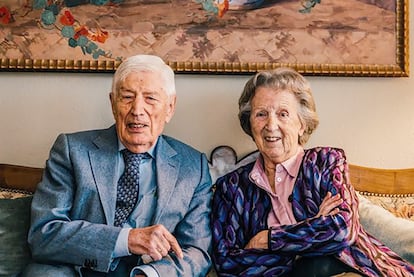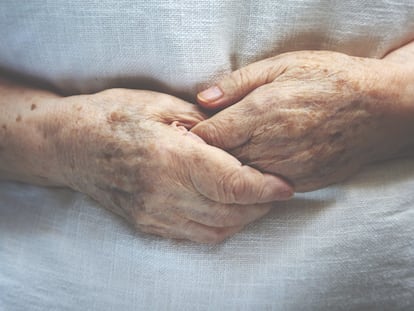Requests for couples euthanasia rise in the Netherlands
The Dutch pioneering law provides for an assessment of each case to ensure that spouses act freely and do not put pressure on one another


Dries and his wife, Eugenie, a 93-year-old Dutch couple who had been together for more than 70 years, died on Monday, February 5, holding hands. Both were very ill and did not wish to be separated. So, they asked for so-called joint euthanasia, a type of euthanasia that has been increasing in recent years. Their request was given the green light by the doctors treating them.
Dries and Eugenie were not just any Dutch couple. He was Dries van Agt, a Catholic and former Christian Democrat prime minister between 1977 and 1982. He and Eugenie Krekelberg had three children and seven grandchildren to whom they said a peaceful farewell. The news was announced four days later, when they had already been buried.
Dries van Agt called his wife “my girl.” She was the cornerstone of his life and neither could contemplate leaving each other behind. A lover of cycling with a cultivated use of the Dutch language that earned him the reputation of being somewhat archaic, Dries met Eugenie when they were students and were rarely apart thereafter. As a Catholic, euthanasia seems an odd choice for Dries van Agt. However, the former prime minister, who ended up voting for the greens and criticized official Dutch policy on the Israel-Palestine conflict, had ditched his Christian Democratic membership. In 2019, he said that euthanasia “would be an option if life and suffering prove unbearable.” That year he had a brain hemorrhage whose fallout grew worse over time while his wife’s health was also in decline. The doctors accepted his request for the pair to die together on the grounds that it met the requirements of the country’s Euthanasia Law, in force since 2002.
In recent years, demand for dual euthanasia has been on the rise. In 2022, it was practiced on 29 couples, or 58 people, according to the annual report published by the Regional Euthanasia Review Committees (RTE), which reviews all those carried out in the country. In 2021, it was administered to 16 couples. In 2020, there were 13, and in 2019, 17. In 2022, doctors carried out a total of 8,720 euthanasias and assisted suicides, both covered by the regulation. This is 5.1% of all deaths registered in the country, and represents an increase of 13.7% compared to 2021. Almost 60% of the patients had cancer.
When the suffering is physical and unbearable due to a terminal condition, the situation is clear. Whereas the moral argument regarding not wanting to be left alone when it comes to couples who are close is not so decisive. And there’s another aspect to consider. Euthanasia should be requested freely and without external pressure. But how to assess whether two people who have been together all their lives have influenced each other to ask for it simultaneously? “Future suffering, if it is concluded that only one of the two meets the conditions for euthanasia, is not considered a criterion. What is evaluated is the situation on the ground and what suffering is currently being experienced,” Sander de Hosson, a lung specialist and author of two books on palliative care, tells EL PAÍS. “Not everyone that asks for euthanasia receives it in the Netherlands, that should be made clear. Although it is true that it is considered a private matter, and we know that it is supported by about 87% of the population.”
The RTEs devoted a passage to practicing euthanasia on couples in their 2018 annual report. The passage sets out that, in such cases, the doctor treating the patients must consult two other consultants to assess each patient separately. In 2022, euthanasia consultant Dominique Rijnja shared a photo on her LinkedIn page of the intertwined hands of a married couple on their deathbed receiving euthanasia. The image got a massive response and also requests for this kind of help, but the law has not relaxed as a result.
In individual euthanasia cases, one doctor treats the patient and another checks that the request complies with the law. In joint euthanasia, there are two supervisors. “Only when these doctors, who talk thoroughly with the patients, have done their job and the situation is clear, does it go ahead,” says De Hosson. “Dutch law always requires insurmountable suffering with no prospect of improvement, and a lucid and repeated request from the patient.” A member of Carend, an association specializing in promoting palliative care, he points out that the Van Agts were very ill. “You cannot pressure a person to opt for this way out. All requests are considered in accordance with current regulations,” he says. The doctors reviewing the case must also refrain from influencing each other, and only exchange patient data if necessary.
The Carend website reports on the case of a couple who had celebrated 48 years of marriage. They were both very ill, lived in a nursing home and wanted to die together at the same time they were married: 3:15 p.m. The doctors of the so-called Euthanasia Expert Center considered that they met the legal requirements and it was carried out in 2022, with the couple’s two children present. Carend is open to requests that comply with the law but which some doctors cannot or prefer not to be involved in. In 2022, Carend was responsible for 14.2% of all euthanasias administered in the Netherlands, according to RTE data.
The figures for 2023 will be ready in the spring and, according to the RTEs, only then will it be clear whether there has been a widespread spike in demand. What is known is that 282 people with dementia requested euthanasia last year. There were also demands from 115 people suffering from one or more serious psychological disorders. On 13 occasions — 0.1% of the total — there was carelessness, i.e., the doctors did not pay attention to all the legal details, but there was no malicious intent found on their behalf.
According to the most recent official report evaluating the law (2017 and 2022), 20% of the 131 doctors surveyed considered the euthanasia procedure to be burdensome. For 69%, it was neutral. Drawn up by researchers at Erasmus University, Rotterdam, and the city’s university hospital, as well as university hospitals in Utrecht and Amsterdam, the report points out that 25% felt pressured at some point by a patient. This 25% was led by geriatricians, followed by general practitioners and specialists. The study, published in 2023, recommends vigilance, given the growing influence of the patient’s own perception of their condition. It also emphasizes the need to better advise doctors in cases of mental illness or dementia. These are the ones that usually end up at the Center of Expertise in Euthanasia, and can face waiting lists.
The Dutch Euthanasia Act was the first of its kind and was passed in 2001. In force since 2002, it is still considered an exceptional practice, not a patient’s right, and can carry up to 12 years’ imprisonment if the legal stipulations are violated. It includes both euthanasia, which is practiced by the doctor, usually at the bedside, and assisted suicide. In the latter case, the person himself administers the product prepared by the doctor.
Sign up for our weekly newsletter to get more English-language news coverage from EL PAÍS USA Edition
Tu suscripción se está usando en otro dispositivo
¿Quieres añadir otro usuario a tu suscripción?
Si continúas leyendo en este dispositivo, no se podrá leer en el otro.
FlechaTu suscripción se está usando en otro dispositivo y solo puedes acceder a EL PAÍS desde un dispositivo a la vez.
Si quieres compartir tu cuenta, cambia tu suscripción a la modalidad Premium, así podrás añadir otro usuario. Cada uno accederá con su propia cuenta de email, lo que os permitirá personalizar vuestra experiencia en EL PAÍS.
¿Tienes una suscripción de empresa? Accede aquí para contratar más cuentas.
En el caso de no saber quién está usando tu cuenta, te recomendamos cambiar tu contraseña aquí.
Si decides continuar compartiendo tu cuenta, este mensaje se mostrará en tu dispositivo y en el de la otra persona que está usando tu cuenta de forma indefinida, afectando a tu experiencia de lectura. Puedes consultar aquí los términos y condiciones de la suscripción digital.









































